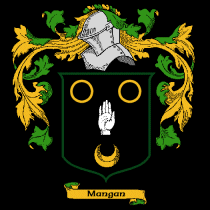|
 Mangan Mangan
The
normal form of Mangan in Irish is O Mongain, which is more phonetically
anglicized as Mongan in parts of Connacht; but even in Mayo,
the original homeland of one of the septs so called, it is more
usually Mangan nowadays. The Munster Mangans, originally Co.
Cork, are now found more in Co.. Limerick. James Clarence Mangan
(1803-1849), the poet, came from Shanagolden, Co. Limerick,
where the family to which he belonged still live. Rev. Edward
Mangin (1772-1852) was also a poet and essayist of note. Mangan
is also found as a synonym of Manahan (a form of Monahan, q.v.)
and of Mannion (q.v.). The Munster Mangans (in Irish O Mongain)
have been long enough established in Co.. Limerick to have a
townland (in the parish of Dromcolliher) called after them viz.
Ballymongane. This is also the name of a townland in the parish
of Termonomongan in Co. Tyrone, appears to be now almost extinct.
There are twelve families of Mangan in the Hearth Money Rolls
for Co. Tipperary (1665-1667). Charles Mongan (1754-1826), son
of Dominic Mungan or Mongan, a Co. Tyrone blind itinerant harper,
became a Protestant and having assumed the surname Warburton
was appointed successively Bishop of Limerick and of Cloyne.
Three brothers named Warburton (viv. 1810-1894) were of sufficient
importance to be included in Crone's Dictionary of Irish Biography.
Though of Offaly they were not in the direct line of the family
of Garryhinch in that county, who were very extensive landowners.
|